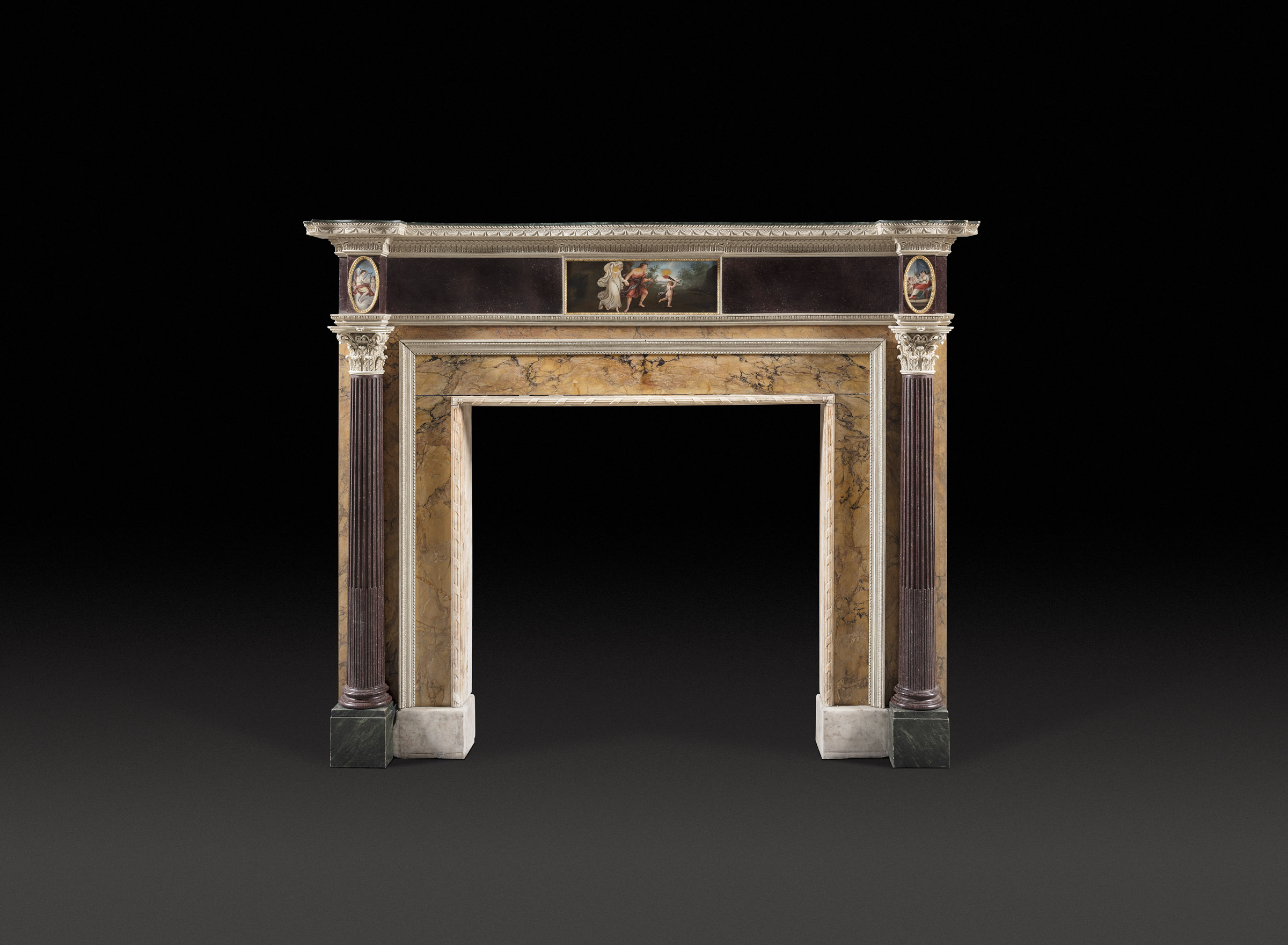
G355
A Superb and Rare George III, Neoclassical Siena and Statuary Marble and Painted Pine Fireplace with Porphyry and Antico Verde Faux Marbles
Circa 1785–95. Inset with painted polychrome copper panels depicting classical scenes after Angelica Kauffman. Attributed to the London workshops of George Brookshaw. With serpentine breakfront shelf protruding over the column jambs, decorated and edged with a continuous band of drapery swags. The porphyry frieze centred with a rectangular copper painted plaque ‘The Rescue from Hades’ with Orpheus, the legendry Thracian poet in his unsuccessful attempt at rescuing his wife Eurydice from Hades, guided by a cupid holding a burning torch as recounted in Ovid’s Metamorphoses.
Kauffman’s original painting was popularised by an engraving by Thomas Burke (1749–1815) in 1782. The end blockings with oval tablets in gilt frames of a reclining Venus with putti and Mercury playing his lyre, both after Giovanni Battista Cipriani (1727–1785) and engraved by Francesco Bartolozzi RA (1721– 1815). The original sienna marble jambs fronted with full rounded Corinthian capped, porphyry columns on Verde Antico foot blocks. The opening framed with white marble.
Provenance
Private collection, London, England. The chimneypiece retains the original painted panels on copper, the original siena marble insert and virtually all the original white painted surface, along with the original faux siena marble decoration and traces of the original Porphyry and Verde Antico faux marble decoration.
A virtually identical chimneypiece without painted panels but with almost identical mouldings and columns, now painted white, is preserved at Duff House in Scotland. Records in the house state that it was sent up from London, but unfortunately do not reveal the maker. Two related chimneypieces by Brookshaw feature identical central painted tablets, supporting the attribution to him. One is currently in the collection of the Philadelphia Museum of Art, and the other was formerly at Grayswood Hill in Haslemere. Both those fireplaces also share many composition mouldings, typical of the Brookshaw oeuvre.
Two other rare fireplaces by Brookshaw with identical painted centre tablets are known, one ex Pelling Place, Windsor, was sold by Sotheby’s London 7th July 2000, lot 81, for £265,000 and another ex Piercefield Park, Monmouthshire, supplied in 1794 and now in the Philadelphia Museum of Art, illustrated in Apollo Magazine, May and June 1991 by Lucy Wood.
George Brookshaw, 1751–1823
Brookshaw exhibited six works including ‘A Sacrifice to Cupid, a Frieze for a Chimneypiece’ at the Free Society of Artists in 1780. He was a cabinet maker and highly skilled painter excelling in botanical decoration as well as figurative and landscape designs for the top ranks of society, attracting many distinguished patrons including the Prince of Wales in 1783. He specialised in furniture and fireplaces, decorated with elaborately painted wood, marble and copper panels from workshops in Mayfair. He went out of business in the mid-1790s but re-emerged as an author and illustrator of painting manuals and horticulture works in the early years of the 19th century including Pomona Britannica 1812. He is thought to have spent the intervening years working as a flower painter under the assumed name of George Brown.
Height 69in (175.5cm) width 86¾in (220cm)
Internal height 45½in (116cm) width 47¼in (120cm)
Footblock to footblock 78in (198cm)
Shelf depth 14in (36.5cm)






